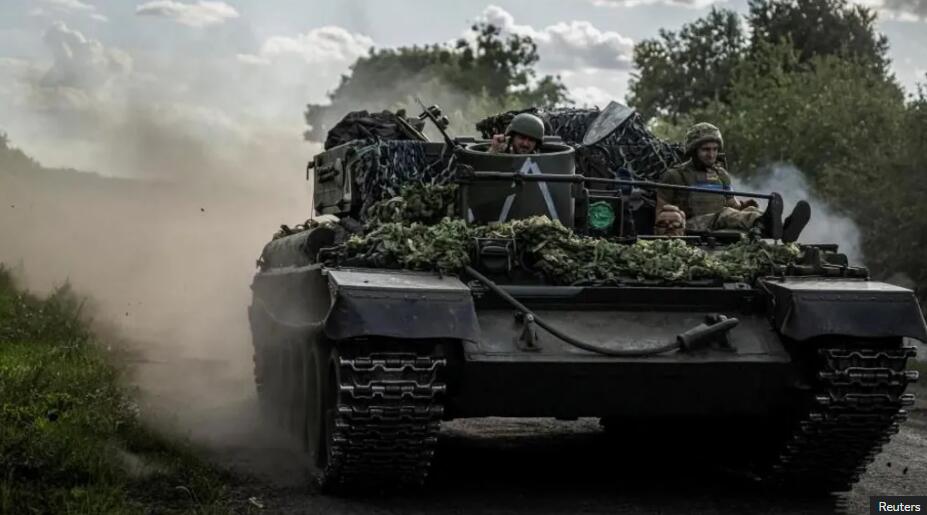We entered easily, say Ukrainian troops involved in Russia incursion
While “Z” might be Russia’s symbol of its invasion, a triangle represents Ukraine’s most audacious attempt to repel it.
They are taped or painted on the sides of every supply truck, tank, or personnel carrier that heads towards the Russian border in the Sumy region.
It’s an offensive that has seized hundreds of square kilometres of Russian territory and palpably restored momentum and morale to Ukraine’s war effort.
The Russian official in charge of the border region of Kursk has spoken of 28 settlements under Ukrainian control and almost 200,000 Russians have fled their homes.
Tomash has just returned from Ukraine’s cross-border mission along with his comrade “Accord”, who nonchalantly says it was “cool”.
Their drone unit had spent two days paving the way for the cross border incursion.
“We had orders to come here, but we didn’t know what that meant,” Tomash admits as he pauses for a coffee at a petrol station.
“We suppressed the enemy’s means of communication and surveillance in advance to clear the way.”
Exactly how much Russian territory has been seized is uncertain, although there is scepticism over Commander-in-Chief Oleksandr Syrskyi’s claim that 1,000 sq km is under Ukrainian control.
Russia’s defence ministry insisted on Tuesday that Ukrainian attempts to push deeper had been thwarted but they have been proved wrong before.
Whatever the reality, it appears Kyiv is committed to this military gamble.
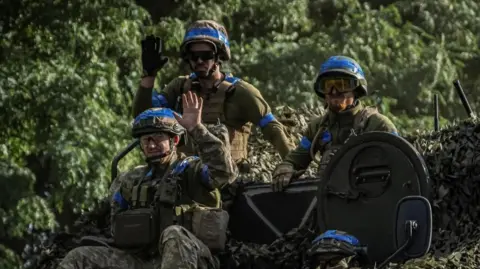 Reuters
ReutersThe level of activity in the neighbouring Sumy region is something I haven’t seen since the liberations of 2022, when there was a feeling of wind in Ukrainian sails.
It’s undoubtedly a welcome departure from the grinding war of attrition of the last 18 months, but to label it a success or failure would be premature.
The goal of this offensive is unclear, although President Volodymyr Zelensky has spoken of targeting sites from which Russia can launch attacks on Ukraine and bringing “a just peace” closer.
But it is evident Kyiv is deploying some of its best troops.
Follow live updates
Ukraine’s incursion: Where does it go from here?
Fit-looking soldiers gather around vehicles that match their muscularity. Most politely decline to talk. Some look exhausted.
Over the Telegram messaging app, a soldier still in Russia tells us months of planning went into forcing Moscow to move troops from other parts of the front line in Ukraine.
“The element of surprise worked,” he says. “We entered easily with little resistance. On 6 August, the first groups crossed at night in several directions.”
“Almost immediately they reached the western outskirts of the city of Sudzha,” he adds.
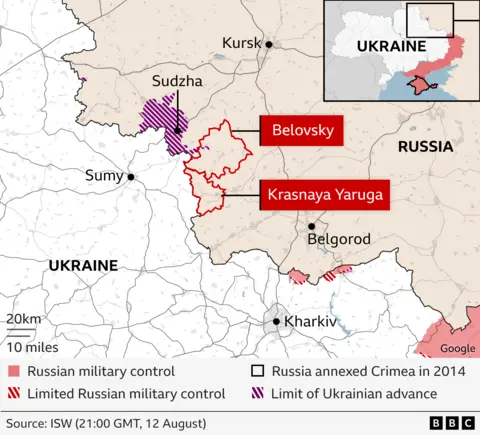
With operations like this, secrecy suits the soldiers carrying them out. The same cannot be said for civilians.
On both sides of the border, tens of thousands are being evacuated after an increase in air strikes and fighting.
“The Russian civilians we encounter don’t resist,” explains the soldier. “We don’t touch them, but they either treat us sharply, negatively, or not at all.”
“They also deceive us about the positions of Russian troops,” he adds.
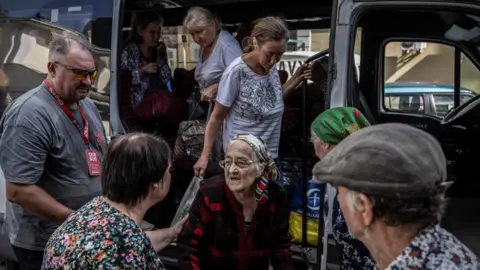 Reuters
ReutersThe soldiers we speak to confirm that Russian forces have indeed been redeployed from the eastern front line, including the Kharkiv, Pokrovsk and Toretsk directions.
But none of them are reporting a slowing of Russian advances, yet.
Vladimir Putin has promised a “worthy response” to the first capture of Russian territory since World War Two.
But any fear he intended to spread has not reached the dusty border settlements habitually bombed by his forces.
Misha and his friend Valera pass us in their orange Lada in the village of Stetskivka.
“I want them to take it [Kursk region] and do this!” says Misha, making a twisting gesture with his hands.
“They should take everything, even Moscow!”
It’s an anger anchored in being on the receiving end of Russia’s relentless full-scale invasion which began in February 2022.
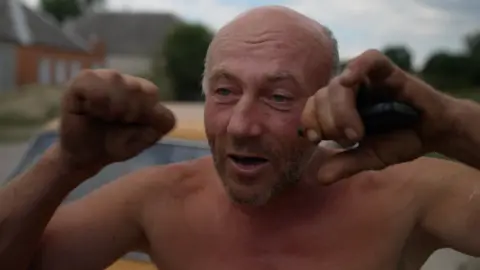
“Russia attacked first, not us,” chimes in Valera with his window down. “Now our guys have responded and shown what we’re capable of. We’d have captured it earlier if we’d had permission.”
Ukraine, it seems, finally has the Western green light it had been yearning for to strike across the border.
The stakes are still dauntingly high, as illustrated by new defences being built on the outskirts of Sumy city.
Until last week, the area had been fearing a Russian offensive in Ukraine’s north. If Ukraine’s incursion fails, those worries could be realised quickly.
Ukrainian forces were, and still are, outnumbered by the Russian aggressors.
“For us to keep hold of this Russian territory we need two things,” writes our Ukrainian soldier on enemy soil.
“More towns like Sudzha under our control, and reserves,” he says.
“Our front line is already bursting at the seams, and it’s not clear where we will get them.”
For Kyiv, the logic or hope is that Russia is forced to switch focus from fighting on Ukrainian soil to its own.
Some in Ukraine believe this counter-offensive could even boost its position in any future peace negotiations.
It could equally push talks even further away.
